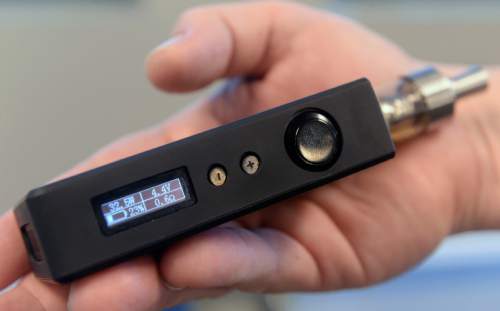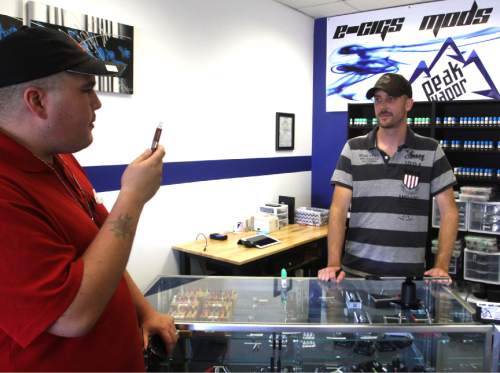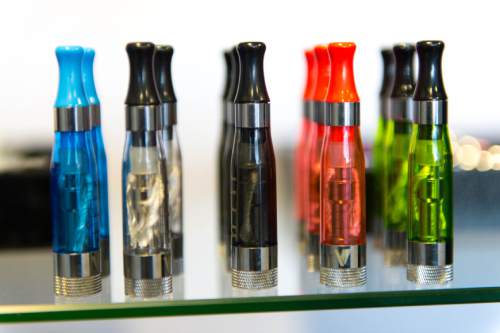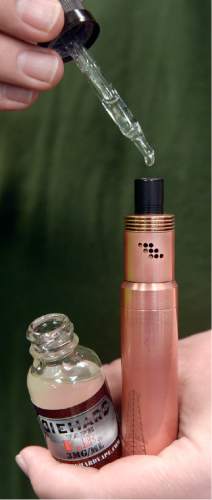This is an archived article that was published on sltrib.com in 2015, and information in the article may be outdated. It is provided only for personal research purposes and may not be reprinted.
Veronica Ford delivered a message Monday to fellow Utah teenagers: Don't fall for the cool mist and bright-colored packaging of increasingly popular e-cigarettes.
Ford, 14, spoke at a news conference in Salt Lake City, where state health officials sounded the alarm about a report that shows nearly twice as many Utah youths used e-cigarettes in 2015 compared with 2013.
"We are on the brink of being the first generation that is tobacco-free, but an electronic device and some candy-flavored juice are threatening to jeopardize all our hard work," said Ford, of Davis County. "Nicotine and its effects on the developing brain are no joke."
While the number of youths who reported using e-cigarettes nearly doubled to 10.5 percent in 2015, adult use of the battery-powered electronic vaporizers that heat liquid nicotine into an inhalable mist has remained steady, state officials said.
Physician Joseph Miner, executive director of the Utah Department of Health, warned that e-cigarette use leads to tobacco addiction. He called on retailers to take the problem seriously and stop selling to anyone under the legal age of 19.
But Gregory Conley, president of the industry group American Vaping Association, said it's simply not accurate to say e-cigarettes lead teens to become regular smokers. He points to declining rates of smoking among youths across the country. In Utah, only 3 percent of youths reporting smoking last year. Since 1999, the number of youths who smoke has declined 71 percent.
"Teen smoking continues to decline despite all the fears and hype about vapor products being a gateway to smoking," Conley said. "This idea that we are going to have this entire culture of children addicted to nicotine is simply not panning out."
E-cigarettes began to appear in the United States in late 2006, but marketing has exploded in recent years.
The drug comes in colored refill packages and an array of candy flavors that critics say make it attractive to young children. They are often described as a less-dangerous alternative to regular cigarettes, but experts say nicotine — including the nicotine in e-cigarettes — is especially harmful to children.
The devices are part of an industry that has grown in the past five years from about $82 million to an estimated $3.5 billion in sales this year, according to Bonnie Herzog, director of Wells Fargo Securities' beverage, tobacco and convenience store research. Of that figure, she added, $1.5 billion comes from e-cigarettes and $2 billion from vapors, tanks, mods and personal vaporizers. Earlier this year, Utah lawmakers passed a measure that requires retailers obtain a license.
It also assigned the state health department to establish standards for product quality, nicotine content, packaging and labeling.
State officials are working on those now, with a set of guidelines set to come out this fall for public review, said Janae Duncan, the state's tobacco-prevention program manager.
Several Utah counties have enacted regulations to govern the sale and manufacture of e-cigarettes and keep them out of the hands of children.
Brian Bennion, executive director of the Weber-Morgan Health Department, said rules in those counties lowered the use e-cigarette use.
Ford, who said she joined the initiative because she's seen the negative impacts of traditional smoking among her own family members, said youths are sucked in by marketing that makes e-cigarettes seem harmless.
"They don't look like cigarettes," Ford said. "They look cool, they look like pens, they look like all these other trendy things going on with my generation."











